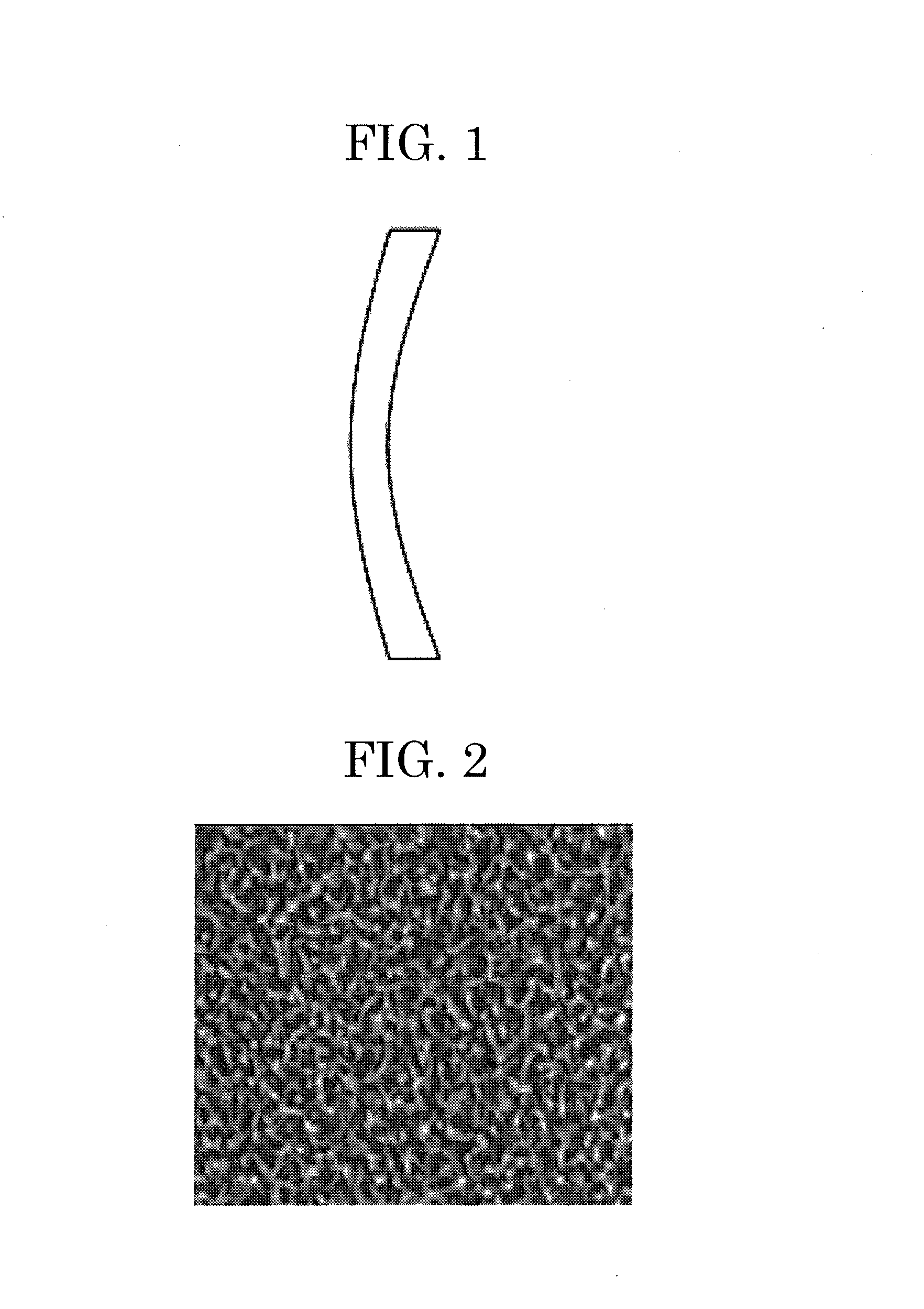Optical member and method for producing same
a technology of optical components and optical components, applied in the field of optical components, can solve the problems of poor film adhesion and coating properties on structures on which liquid readily collects, incompatibility with the conventional method of laminating oxide thin films used for lenses, and inconvenient production, etc., to achieve high film adhesion, easy formation, and easy control of film thickness
- Summary
- Abstract
- Description
- Claims
- Application Information
AI Technical Summary
Benefits of technology
Problems solved by technology
Method used
Image
Examples
example 1
Production of Optical Member
[0073]As a substrate, a concave meniscus lens (material S-TIH6, manufactured by OHARA INC.) shown in FIG. 1 was used. The concave meniscus lens employed a glass having a refractive index for d-line of 1.805.
[0074]The concave meniscus lens was subjected to ultrasonic cleaning using pure water (45 kHz, for 3 minutes), and then, dried by a spin dryer and baking at 150° C.
[0075]Next, the concave meniscus lens was placed at an EB deposition apparatus (manufactured by ULVAC, Inc., EBX-8) so that deposition was conducted on the concave surface of the lens. Vacuuming was carried out up to a vacuum degree of 2.0×10−6 Torr.
[0076]Next, aluminum oxide was deposited by electron beam vapor deposition using a crystal oscillator as a guide so that the thickness was 58 nm.
[0077]Next, metal aluminum was deposited thereon so that the thickness was 5 nm.
[0078]Next, the concave meniscus lens was placed at the EB deposition apparatus (manufactured by ULVAC, Inc., EBX-8) so tha...
example 2
[0088]An optical member of Example 2 was produced by the same procedure as that in Example 1 except that SiO2 was deposited so that the thickness was 53 nm instead of depositing aluminum oxide so that the thickness was 58 nm in Example 1.
[0089]FIG. 5 shows spectral reflectances of the obtained optical member. Measurement was performed for the reflectances on front and back surfaces. FIG. 5 shows reflectances at incident angles of 5 degrees, 12 degrees, 30 degrees, and 45 degrees. Further, Table 2 shows average reflectances for light ranging from 380 nm to 780 nm at incident angles of 5 degrees, 12 degrees, 30 degrees, and 45 degrees.
TABLE 2Incident angleVisible light average reflectance (%) 5 degrees0.4012 degrees0.4230 degrees0.5945 degrees1.19
[0090]FIG. 5 and Table 2 revealed that the average reflectances at incident angles of 5 degrees and 45 degrees were 0.80%, which indicated that the antireflection effect could be widely exerted on incident light coming from front to oblique d...
example 3
[0091]An optical member of Example 3 was produced by the same procedure as that in Example 2 except that the time of the hydrothermal treatment using boiling water was changed to 60 minutes from 20 seconds. At this time, prolonged hydrothermal treatment using boiling water allowed alumina in the convex portion in the outermost concave-convex structure to be dissolved out gradually, and the average height of the convex portion was reduced to 50 nm. Table 3 shows relation between the incident angle and the reflectance.
TABLE 3Incident angleVisible light average reflectance (%) 5 degrees0.9012 degrees0.9330 degrees1.2545 degrees2.56
[0092]Table 3 revealed that Example 3 had a sufficiently higher antireflection effect in comparison with that of Comparative Example 1, but has a slightly lower antireflection property in comparison with that of Example 2 due to reduced average height of the convex portion.
PUM
| Property | Measurement | Unit |
|---|---|---|
| temperature | aaaaa | aaaaa |
| height | aaaaa | aaaaa |
| thickness | aaaaa | aaaaa |
Abstract
Description
Claims
Application Information
 Login to View More
Login to View More - R&D
- Intellectual Property
- Life Sciences
- Materials
- Tech Scout
- Unparalleled Data Quality
- Higher Quality Content
- 60% Fewer Hallucinations
Browse by: Latest US Patents, China's latest patents, Technical Efficacy Thesaurus, Application Domain, Technology Topic, Popular Technical Reports.
© 2025 PatSnap. All rights reserved.Legal|Privacy policy|Modern Slavery Act Transparency Statement|Sitemap|About US| Contact US: help@patsnap.com



